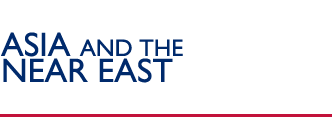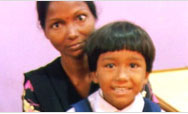 |
|
 |
 |
|
 |
 |

|
- Solomon Islands, 04/07: U.S. Provides Emergency Assistance to the Solomon Islands
- Indonesia, 03/07: Indonesia
Sesame Street Unveils Muppeteers Behind-the-Scenes
- India, 03/07: U.S.
Co-sponsors Conference On Power Sector In South Asia
- Lebanon, 03/07: United
States Signs Memorandum of Understanding with Ministry of Education
to Upgrade Lebanese Public Schools
- Jordan, 03/07: Jordanian
Children Use Art to Express Their Rights
- Indonesia, 03/07: U.S.
to Provide $100,000 for Earthquake Victims in West Sumatra
- India, 03/07: USAID
Supports Education and Employment Summit
- Mongolia, 03/07: U.S. Assists Mongolian Cashmere Industry
- Afghanistan, 03/07: $218.6 Million Contract Awarded to Bolster Afghanistan's Public, Private Sectors
- Indonesia, 03/07: U.S. Provides Assistance to Earthquake Victims in Indonesia
|
|
 |
 |
|
Asia and the Near East
Home Page
Asia and Near East Bureau is now Asia Bureau and the Middle East Bureau
Effective March 2, 2008, the Bureau for Asia and the Near East (ANE) will be divided into two separate, regional bureaus: the Asia Bureau and the Middle East Bureau. These two bureaus have been created in order to enhance oversight and strengthen inter-agency coordination for USAID programs in these regions. The Central Asian Republics, Kazakhstan, Kyrgystan, Tajikistan, Turkmenistan and Uzbekistan, were previously grouped in USAID’s Europe & Eurasia Bureau, will relocate to the Asia Bureau to further promote greater integration between the South and Central Asia regions, and to create new North-South linkages and promote closer regional ties of economic, security and democratic nature.
Overview
USAID operates in 26 countries and territories in Asia, the
Middle East and North Africa. This vast and diverse region
faces many challenges, including terrorism, instability, an
exploding youth population, high unemployment, corruption,
poor education systems, HIV/AIDS and environmental degradation.
Challenges
The Asia and Near East region is home to 800 million impoverished
people, more than Africa and Latin America combined. More
than 600 million people in the region cannot read or write
– the highest levels of illiteracy in the world. In
South Asia alone, 57 percent of women are illiterate. The
region is governed by some of the world’s most closed
and repressive regimes, which impose restrictions on human
freedoms and impede progress and opportunities.
In East and South Asia, HIV/AIDS is destroying communities
and bankrupting social systems. Eight million people in Asia
are HIV positive, including one million who became infected
in the past year alone. Unless HIV/AIDS prevention improves,
Asia could have 40 million infected people by the year 2010.
Rapid industrialization and growing populations are straining
the region’s environmental systems. Urban air pollution
levels in the region are among the highest in the world, and
the consumption of natural resources is occurring at an unsustainable
rate.
Inadequate economic opportunity, the lack of education and
skills training, and poor prospects for long-term health and
prosperity reinforce intolerance and extremism and provide
fertile ground for local and regional unrest.
Program Areas
USAID responds to these challenges with innovative programming
that emphasizes trade, education, health and democracy to
promote country and regional stability and create a more secure,
democratic, and prosperous world. Programs also support HIV/AIDS
prevention and treatment in 15 Asian countries and promote
the adoption of clean and efficient technologies and policies
that encourage positive relationships between economic growth
and environmental protection. Each country program is guided
by a multi-year strategic plan that identifies the sectors
in which USAID will work and estimated levels of funding.
Operations
The ANE bureau and field offices work in close partnership
with U.S. and local non-governmental organizations, private
businesses, universities, international organizations, and
the governments of host countries to achieve long-lasting
results. In Fiscal Year 2007, ANE is managing nearly $3.5 billion
in U.S. assistance activities across the region.
Back to Top ^
|


